

|
by Joseph Brennan. Copyright 2001, 2002. |
Pennsylvania extra platformsPassenger service: Jun 1937 - about 1952Existing abandoned portions: 3 platforms, used occasionally. Touring: Newark City Subway. Broad St, part of platformsPassenger service: May 1935 - 1983.Existing abandoned portions: part of 2 platforms. Touring: Newark City Subway. Washington St, part of platformsPassenger service: May 1935 - 1983.Existing abandoned portions: part of 2 platforms. Touring: Newark City Subway. Warren St, part of platformsPassenger service: May 1935 - 1983.Existing abandoned portions: part of 2 platforms. Touring: Newark City Subway. construction and operationThe Newark City Subway was built by the City of Newark in 1929-1937 to provide an off-street route for some of the Public Service trolley lines. The route was the former bed of the Morris Canal. The project officially called the "city railway" is just over four miles in length with one mile in tunnel under Raymond Boulevard. The underground portion has four stations: Penn Station, Broad St, Washington St, and Warren St. The line was opened from Broad St to Heller Parkway in May 1935, and the extension to Penn Station was opened in June 1937 together with the Pennsylvania Railroad's new station. Penn Station Newark was possibly the first intermodal transportation station, with dedicated areas for: mainline railroad trains, Hudson and Manhattan (now PATH) rapid transit trains, bus lanes, and the City Subway. The City Subway connected to street trolley lines at five locations. In the subway, ramps were provided west of Penn Station into the Public Service Terminal lower level, and west of Washington St up to the street at Warren St. Above ground, there were ramps to Central Ave west of Norfolk St station, a turnout into the street crossing at Orange St station, and ramps to Bloomfield Ave east of Bloomfield Ave station. The following car lines operated to the underground stations shown:
to Penn, Broad St, Washington St, Warren St:
to Penn, Broad St, Washington St (out via Warren St ramps):
to Penn only (out via Public Service Terminal): The four routes that ran out via the Public Service Terminal were very short-lived because Public Service Coordinated Transport converted them to All Service Vehicles, a hybrid trolleybus and gasoline-electric bus. The company considered ASVs the next generation transit vehicle and converted all of their trolley lines except those running into the Newark City Subway and the Hoboken Elevated. The three routes (21 23 29) that ran farther in the subway lasted till after the war, when the diesel bus became practical and Public Service abandoned ASVs. Routes 21 (short turns to Roseville Ave) and 29 were the last two street trolley routes in New Jersey, closed in 1952. The City Subway station at Penn Station has two inbound tracks with platforms leading to a doubletrack loop to three outbound tracks with platforms. Since 1952, the one remaining route, 7 City Subway, normally operates on the outer or right-hand tracks. The other platforms could be considered abandoned, but they are still used from time to time. The way stations were designed for later conversion to rapid transit train operation. Before the abandonment of the three street lines, the long platforms allowed more than one car to make a stop. During station renovations in 1983-1984, about half the platform length was closed off at Broad St, Washington St, Warren St, and the non-underground stations, and the remaining open part was cleaned and renovated. |
diagram |
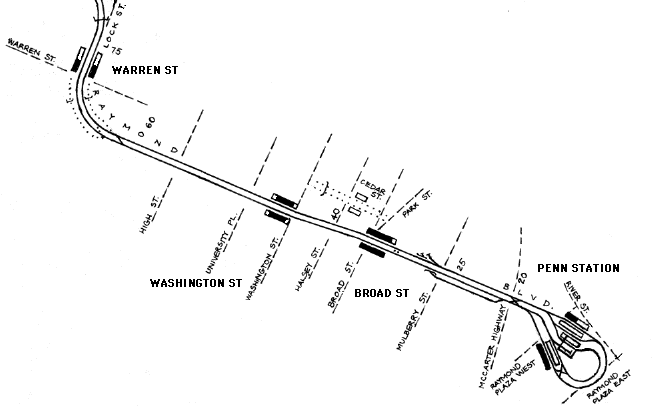
|
The underground portion of the City Subway runs under Raymond Boulevard from Penn Station loop to Warren St, and under one block of Lock St. The ramps to Public Service Terminal have track for a short distance and are used to store work cars. The ramps to Warren St have no track. |
|
At Penn Station, passengers ready themselves to board an outbound car on the usually open outer track in 1999. On the right beyond the fence and gate is track 2, usually not in use, and unseen beyond that is track 3. Photo copyright 1999 by Jon Bell. See http://web.presby.edu/~jtbell/transit/Newark/Subway/. |
|
The two inbound tracks have escalators up to the railroad station at street level. The track at right is the one usually used. Photo copyright 1999 by Jon Bell. See http://web.presby.edu/~jtbell/transit/Newark/Subway/. |
|
Cars sometimes arrive on the inner track, as this car did in June 2001, seen looking back from the base of the escalator. The stairway is not open to the public. |
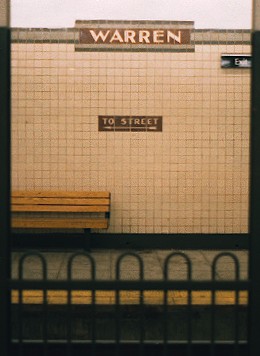
At Warren St, about half the platform length is closed. There is just one stairway to each platform, and its landing was enlarged in 1983-1984 to block access to the northern or western half of each platform. Views here are from the inbound side, looking at the outbound side, in 2001. |
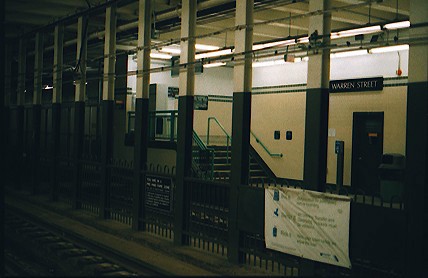
|
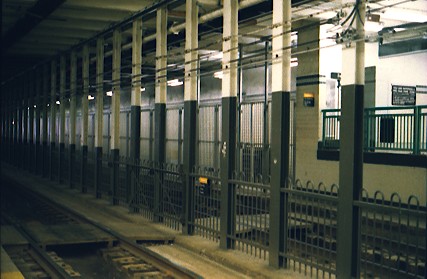
|
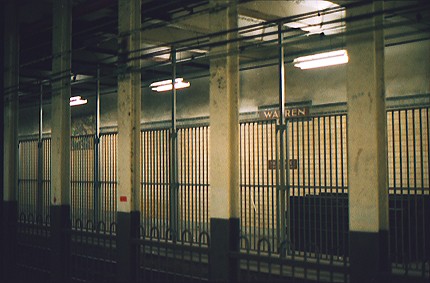
|

|
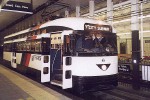 Photos of the Newark City Subway can be found on the New York Subway Resources site, http://www.nycsubway.org. |
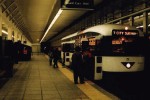 More photos of the Newark City Subway can be found on Jon Bell's web page. |